-
 Bitcoin
Bitcoin $111000
1.68% -
 Ethereum
Ethereum $4289
-0.42% -
 XRP
XRP $2.830
2.60% -
 Tether USDt
Tether USDt $1.000
-0.01% -
 BNB
BNB $849.8
0.18% -
 Solana
Solana $208.0
4.92% -
 USDC
USDC $0.9999
0.00% -
 Dogecoin
Dogecoin $0.2130
1.23% -
 TRON
TRON $0.3371
0.04% -
 Cardano
Cardano $0.8289
3.22% -
 Chainlink
Chainlink $23.25
3.34% -
 Hyperliquid
Hyperliquid $44.68
3.12% -
 Ethena USDe
Ethena USDe $1.001
0.01% -
 Sui
Sui $3.318
2.93% -
 Bitcoin Cash
Bitcoin Cash $580.2
6.25% -
 Stellar
Stellar $0.3633
2.30% -
 Avalanche
Avalanche $24.40
5.43% -
 Hedera
Hedera $0.2200
3.20% -
 Cronos
Cronos $0.2739
3.94% -
 UNUS SED LEO
UNUS SED LEO $9.551
0.01% -
 Litecoin
Litecoin $111.0
1.76% -
 Toncoin
Toncoin $3.160
1.58% -
 Shiba Inu
Shiba Inu $0.00001235
2.28% -
 Polkadot
Polkadot $3.800
2.85% -
 Uniswap
Uniswap $9.501
1.73% -
 Bitget Token
Bitget Token $5.165
10.67% -
 World Liberty Financial
World Liberty Financial $0.2236
-9.69% -
 Dai
Dai $0.9998
-0.01% -
 Monero
Monero $267.2
2.64% -
 Aave
Aave $313.6
2.60%
Common smart contract vulnerabilities
To enhance smart contract security, developers should implement reentrancy guards, use SafeMath libraries, enforce strict access control, and avoid complex logic in fallback functions.
Jul 12, 2025 at 01:21 am
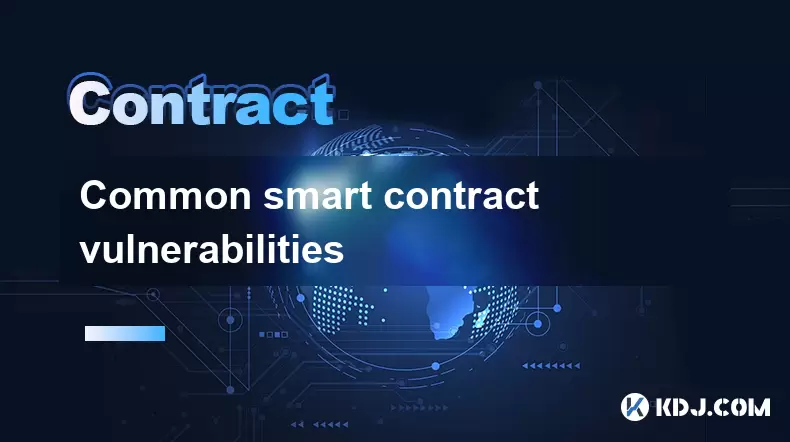
Reentrancy Attacks
One of the most infamous vulnerabilities in smart contracts is the reentrancy attack, which famously led to the DAO hack in 2016. This vulnerability occurs when a malicious contract calls back into the original contract before the initial function execution completes. As a result, functions that handle external calls without proper checks can be exploited.
To prevent reentrancy attacks, developers should avoid making external calls to unknown or untrusted contracts. A common mitigation technique is using the Checks-Effects-Interactions pattern. This involves updating the state of the contract before making any external calls. Additionally, implementing reentrancy guards using mutex locks can help block recursive calls.
Another method is to use well-audited libraries such as OpenZeppelin’s ReentrancyGuard, which provides modifiers like nonReentrant to restrict function re-entry during execution. Developers must also consider limiting the amount of Ether or tokens that can be transferred in a single call to reduce potential damage from such attacks.
Integer Overflow and Underflow
Smart contracts written in Solidity versions prior to 0.8.0 are susceptible to integer overflow and underflow. These occur when arithmetic operations result in values that exceed the maximum or fall below the minimum allowed value for a given data type, such as uint256.
For example, if a variable of type uint256 holds the value 0 and is decremented, it will underflow to the maximum value (2^256 - 1), potentially leading to incorrect balances or unauthorized access. To mitigate this, developers should use SafeMath libraries provided by OpenZeppelin, which perform explicit checks on arithmetic operations.
Starting with Solidity 0.8.0, these checks are enabled by default, and arithmetic operations will throw errors on overflows or underflows unless explicitly unchecked using unchecked { ... } blocks. However, even with this built-in protection, developers must remain cautious when disabling safety checks for performance optimization.
It's also crucial to validate all inputs and ensure that mathematical operations are bounded correctly, especially when dealing with user-provided values or dynamic calculations involving token transfers.
Front-running Attacks
In public blockchains like Ethereum, transactions are visible before they are mined, which opens the door for front-running attacks. Attackers can observe pending transactions and submit their own with higher gas fees to have them executed first, thereby manipulating outcomes.
This vulnerability commonly affects decentralized exchanges (DEXs) and other applications where transaction order matters. For instance, if a user submits a trade at a certain price, an attacker could front-run that transaction to get a better rate, effectively stealing value.
To defend against front-running, developers can implement mechanisms such as commit-reveal schemes. In this approach, users first submit a hashed version of their transaction (commit phase), and only later reveal the full details (reveal phase), preventing attackers from knowing the exact action until it's too late.
Alternatively, using randomness or time-based conditions within contracts can make predicting transaction outcomes more difficult. However, true randomness on-chain is challenging, so developers often rely on off-chain oracles or cryptographic commitments to obscure sensitive information.
Improper Access Control
Access control is a critical aspect of secure smart contract development. Improper access control can lead to unauthorized execution of privileged functions, allowing attackers to change contract states, drain funds, or disable contract functionality.
A typical mistake is not restricting who can call sensitive functions. For example, a function meant to be called only by the contract owner might lack a modifier like onlyOwner, enabling anyone to invoke it. Another issue arises when permissions are hardcoded or not properly revoked after use.
To address this, developers should utilize role-based access control patterns, such as those found in OpenZeppelin’s Ownable and Roles libraries. Functions that alter critical parameters should include require statements or modifiers that verify the caller's identity or role.
Additionally, multi-signature wallets can be used for administrative actions, requiring multiple approvals before executing high-risk operations. Regular audits and testing of permissioned functions are essential to ensure that no unintended access paths exist.
Denial-of-Service (DoS) Vulnerabilities
Smart contracts can become victims of denial-of-Service (DoS) attacks, where malicious actors prevent legitimate users from interacting with the contract. This can happen through various means, such as forcing excessive gas consumption or blocking execution paths indefinitely.
One example is a contract that loops through an array of addresses to send Ether. If one of the recipients has a fallback function that consumes excessive gas or reverts, it can cause the entire loop to fail, leaving funds stuck.
To mitigate DoS risks, developers should avoid loops that depend on dynamic arrays. Instead, off-chain solutions or pull-over-push payment models can be implemented, where users initiate withdrawals themselves rather than being pushed funds automatically.
Furthermore, contracts should include fallback mechanisms in case of failure, such as allowing manual intervention by an admin or retrying failed operations. Using gas limits and timeouts within function calls can also prevent indefinite blocking.
Fallback Function Vulnerabilities
Fallback functions serve as default handlers for Ether transfers or unrecognized function calls. However, if not carefully designed, they can introduce serious security flaws. The fallback function must be kept simple and should not contain complex logic or state changes.
A notable risk is when a fallback function contains a loop or calls another contract, increasing the chance of out-of-gas exceptions or reentrancy. Moreover, if a contract relies on receiving Ether via the fallback but doesn't account for scenarios where the sender uses transfer() or send(), it may fail unexpectedly due to the limited gas forwarded.
Developers should ensure that fallback functions either reject unexpected Ether with a revert or handle minimal logic. It's also recommended to separate payable and non-payable fallback behaviors by using receive() and fallback() functions introduced in Solidity 0.6.0.
Auditing fallback logic thoroughly and testing edge cases, such as sending Ether from contracts with custom fallbacks, is essential to avoid disruptions or exploits.
Frequently Asked Questions
What tools can I use to detect smart contract vulnerabilities?You can use static analysis tools like Slither, MythX, and Oyente to identify common vulnerabilities. Platforms like OpenZeppelin Defender and Tenderly offer runtime monitoring and debugging capabilities. Always combine automated tools with manual code reviews and formal verification for comprehensive coverage.
How can I test for reentrancy in my smart contract?Write unit tests that simulate external calls to malicious contracts designed to reenter your functions. Use Hardhat or Truffle frameworks to deploy and interact with mock contracts. You can also leverage fuzzing tools like Echidna to automate testing of edge cases.
Is it safe to use inline assembly in Solidity?Inline assembly grants low-level control over the EVM but bypasses many of Solidity’s safety features. It should only be used by experienced developers and thoroughly reviewed. Avoid using it unless absolutely necessary for optimization or specific EVM features.
Can a contract be upgraded securely after deployment?Yes, upgradeable contracts using proxy patterns allow updates while preserving state. However, they introduce complexity and new attack surfaces. Use established upgradeability patterns like Transparent or UUPS proxies from OpenZeppelin and ensure proper access controls and thorough testing.
Disclaimer:info@kdj.com
The information provided is not trading advice. kdj.com does not assume any responsibility for any investments made based on the information provided in this article. Cryptocurrencies are highly volatile and it is highly recommended that you invest with caution after thorough research!
If you believe that the content used on this website infringes your copyright, please contact us immediately (info@kdj.com) and we will delete it promptly.
- Crypto Presales in 2025: Unveiling ROI Opportunities and the Next Big List
- 2025-09-03 18:25:13
- Shiba Inu, Pepe Coin, and Remittix Presale: What's the Buzz?
- 2025-09-03 19:05:14
- XRP Price Watch: Descending Trendline Meets ETF Hopes
- 2025-09-03 18:45:12
- Epstein Files, Trump Crypto, and China's Parade: A Week in the Whirlwind
- 2025-09-03 18:45:12
- Justin Sun, DeFi, and the WLFI Move: A NYC Perspective
- 2025-09-03 19:25:15
- XRP, Gemini, and SEC Clarity: Navigating the Crypto Landscape in 2025
- 2025-09-03 19:45:12
Related knowledge
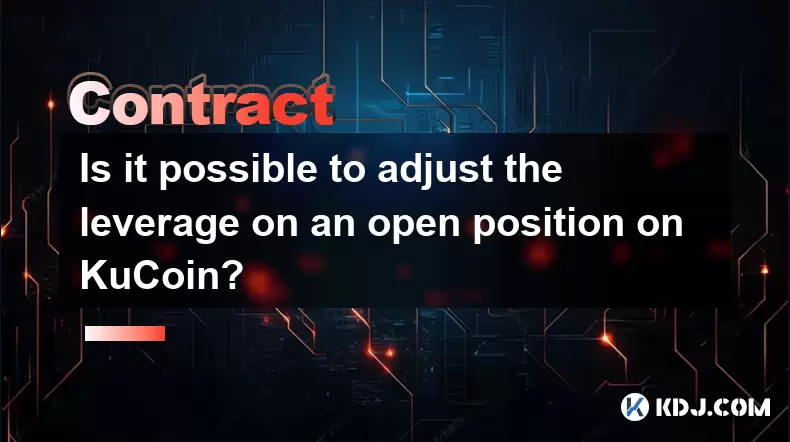
Is it possible to adjust the leverage on an open position on KuCoin?
Aug 09,2025 at 08:21pm
Understanding Leverage in KuCoin Futures TradingLeverage in KuCoin Futures allows traders to amplify their exposure to price movements by borrowing fu...
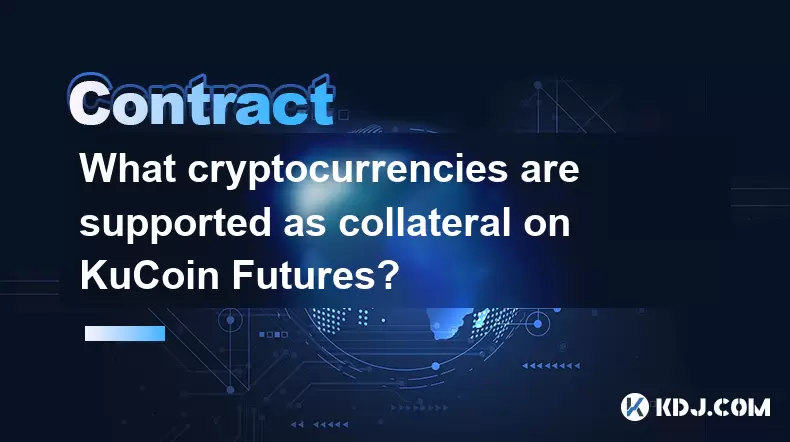
What cryptocurrencies are supported as collateral on KuCoin Futures?
Aug 11,2025 at 04:21am
Overview of KuCoin Futures and Collateral MechanismKuCoin Futures is a derivatives trading platform that allows users to trade perpetual and delivery ...
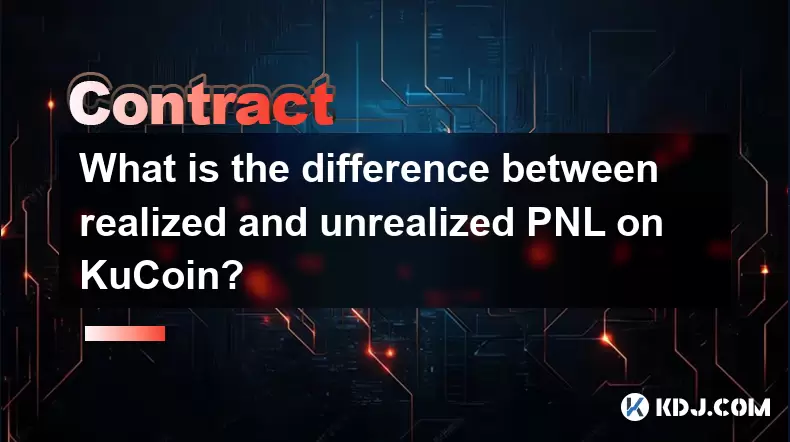
What is the difference between realized and unrealized PNL on KuCoin?
Aug 09,2025 at 01:49am
Understanding Realized and Unrealized PNL on KuCoinWhen trading on KuCoin, especially in futures and perpetual contracts, understanding the distinctio...

What different order types are available to use on KuCoin Futures?
Aug 13,2025 at 11:35am
Understanding Order Types on KuCoin FuturesKuCoin Futures offers a comprehensive range of order types to accommodate different trading strategies and ...
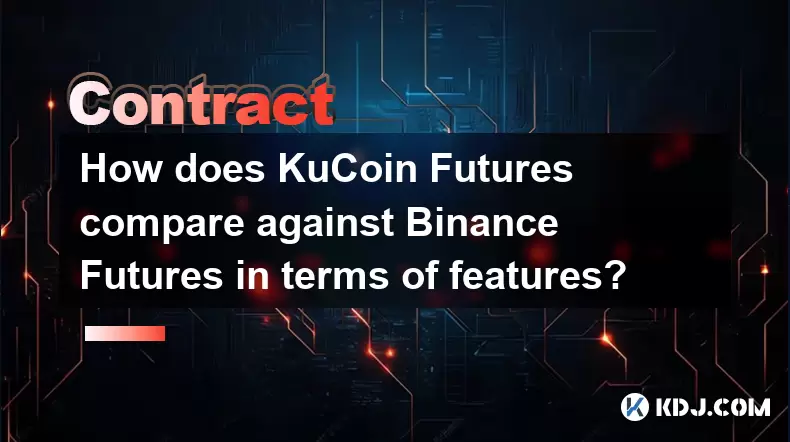
How does KuCoin Futures compare against Binance Futures in terms of features?
Aug 09,2025 at 03:22am
Trading Interface and User ExperienceThe trading interface is a critical component when comparing KuCoin Futures and Binance Futures, as it directly i...

How can I manage risk when applying high leverage on KuCoin?
Aug 13,2025 at 11:35am
Understanding High Leverage and Its Implications on KuCoinHigh leverage in cryptocurrency trading allows users to control larger positions with a rela...

Is it possible to adjust the leverage on an open position on KuCoin?
Aug 09,2025 at 08:21pm
Understanding Leverage in KuCoin Futures TradingLeverage in KuCoin Futures allows traders to amplify their exposure to price movements by borrowing fu...

What cryptocurrencies are supported as collateral on KuCoin Futures?
Aug 11,2025 at 04:21am
Overview of KuCoin Futures and Collateral MechanismKuCoin Futures is a derivatives trading platform that allows users to trade perpetual and delivery ...

What is the difference between realized and unrealized PNL on KuCoin?
Aug 09,2025 at 01:49am
Understanding Realized and Unrealized PNL on KuCoinWhen trading on KuCoin, especially in futures and perpetual contracts, understanding the distinctio...

What different order types are available to use on KuCoin Futures?
Aug 13,2025 at 11:35am
Understanding Order Types on KuCoin FuturesKuCoin Futures offers a comprehensive range of order types to accommodate different trading strategies and ...

How does KuCoin Futures compare against Binance Futures in terms of features?
Aug 09,2025 at 03:22am
Trading Interface and User ExperienceThe trading interface is a critical component when comparing KuCoin Futures and Binance Futures, as it directly i...

How can I manage risk when applying high leverage on KuCoin?
Aug 13,2025 at 11:35am
Understanding High Leverage and Its Implications on KuCoinHigh leverage in cryptocurrency trading allows users to control larger positions with a rela...
See all articles

























































































